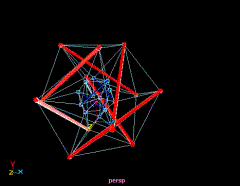Shear: Difference between revisions
m (→Links and References: added a space) |
m (2 revisions imported) |
(No difference)
| |
Latest revision as of 22:22, 11 April 2022
Read here about shear forces in tensegrity structures.
Definition
To define shear we follow Thomas J. Avery's explanation for lay people [1]:
Shear is one of five abstract load categories of forces used in analyzing structure. The five forces are tension, compression, bending, torsion and shear.
Shear is a force that attempts to slice apart a structural member. Imagine two hands on an imaginary bar. Now imagine pulling one hand towards you and pushing the other hand away from you. The force of shear is the force acting on the bar that wants to slice it in half.
The other four forces, in short:
- Tension is a force acting to pull a structural member apart. Imagine a bar with your hands at its opposite ends: now attempt to pull your hands apart. The bar is under tension now, with its loads are perfectly in-line with the member’s axis.
- Compression is a force squeezing a structural member together. Imagine a bar with your hands at its opposite ends: now attempt to join your hands. The loads are perfectly in-line with the member’s axis, like this:
- Bending (or “bending moment”, or sometimes just “moment”) is a curving of a structural member. Imagine grabbing a long bar with two hands, and then rotating your wrists in opposite directions to make the bar curve into an arch-like shape. This is a complex loading situation where the top fibers of the bar (i.e. the “outside” fibers of the curved member) experience tension, and the inside fibers of the bar experience compression.
- Torsion is a twisting of a structural member. Again, imagine grabbing a long bar with two hands and then trying to wring it as if you were twisting a damp washcloth and trying to squeeze moisture out of it.
In real life, pure loads do not exist by themselves. Loading on a structural member is usually a combination of two or more load types. For example, the frame rails in your vehicle will probably experience tension, bending, shear, and torsion as you drive along. A column in a building frame will likely experience compression, bending, and shear at the same time.
Burkhardt notes that shear forces can be neglected, and only the axial tensile and compressive forces need to be taken into account in tensegrity force analysis [2].
Shear in Biotensegrity
Eddy Y. Xuan of Biomedical Communications, University of Toronto, Canada, published on the Children’s Hospital , Boston’s website, reports of shear behavior in cellular mechanics, as predicted by tensegrity structural modelling. That report features the image below.
Levin critiques Xuan's approach, stating that these diagrams do not represent the mechanics of tensegrity structures. "Xuan depicts linear deformations, standard Poisson Ratio stuff, but that is not how tensegrity structures respond to stress... The error occurs when the model used to understand tensegrity uses weak elastics as the tension elements. In true tensegrities, the tension elements get stiffer as the structure is loaded, but not so in the rubber band models. If you use nylon fishing line, as does Hamilton, the response to loading more closely represents true tensegrities." [3]
Links and References
[1] Thomas J. Avery, www.texbrick.com
[2] A Practical Guide to Tensegrity Design, 2nd edition, Copyright 2004-2008 by Robert William Burkhardt, Jr., USA7.1 Force Analysis: Introduction.
[3] Levin, Shear or not to shear, http://www.biotensegrity.com/shear_or_not.php
